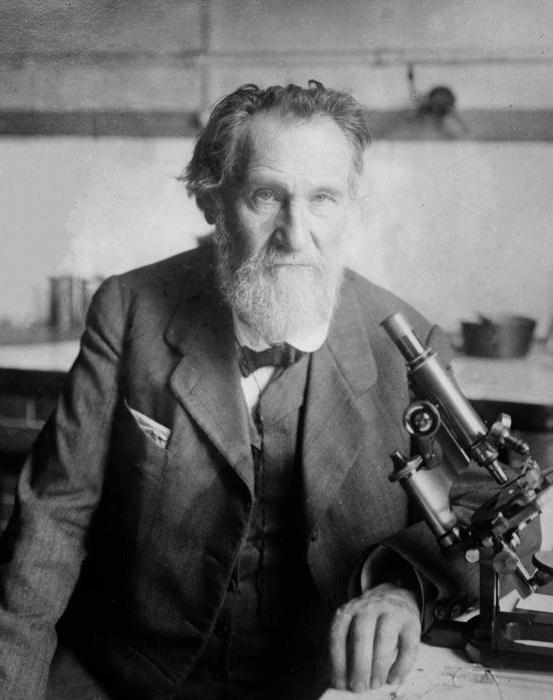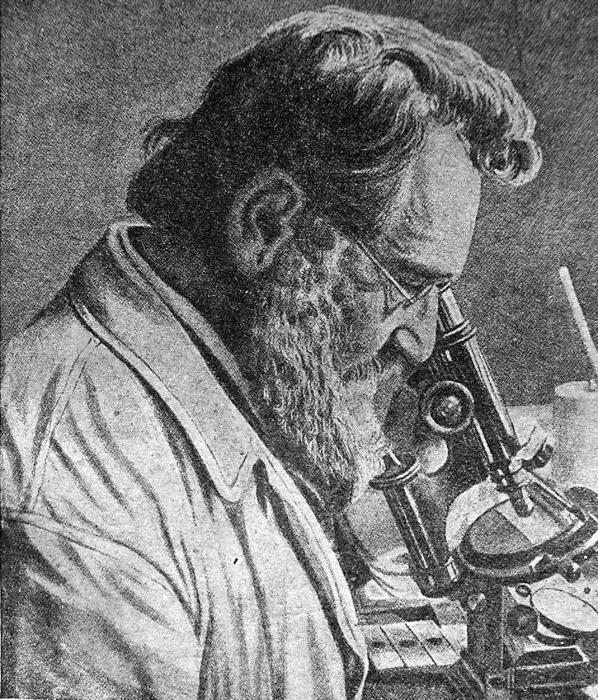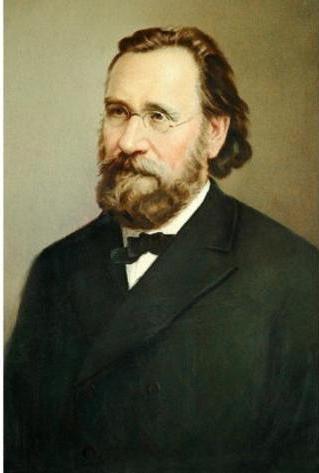Ilya Ilyich Mechnikov, whose biography (life story) is very interesting, is a Russian embryologist, immunologist and bacteriologist. This scientist gave us many important discoveries in science. In 1908, he was awarded the Nobel Prize in Physiology or Medicine. However, this is only one of the many achievements of Ilya Ilyich. A brief biography of Ilya Ilyich Mechnikov will introduce you to life and the main discoveries made by this scientist.
About Ilya Ilyich heard both domestic and foreign biologists, immunologists and physiologists. Mechnikov productively worked as a zoologist, and as an embryologist, and as a pathologist. He is one of the creators of evolutionary embryology. In addition, he owes the merit of discovering intracellular digestion and phagocytosis, and much more. All of this is more than enough for many of you to be interested in a brief biography of Ilya Ilyich Mechnikov.
The origin of the future scientist
He was born in the village of Ivanovka (near Kharkov, Ukraine) in 1845. His father was an officer in the army of the Tsarist secret police, Ilya Ivanovich, who served in St. Petersburg. Before moving to the Ukrainian estate, this man lost a significant part of his wife’s dowry and family property to the cards. Emilia Mechnikova (in girlhood - Nevakhovich) was the mother of Ilya Ilyich. The father of this woman was a wealthy Jewish writer Lev Nevakhovich. Emilia helped her son, the last of 5 children, to choose a career as a scientist.
Education at the Lyceum and University
A brief biography of Ilya Ilyich Mechnikov is marked by the fact that from childhood he showed interest in natural science. The future scientist studied well at the Kharkov Lyceum. At the age of 16, Mechnikov wrote an article criticizing a geology textbook. It was published in a Moscow magazine. After graduating from high school with a gold medal (in 1862), Ilya Ilyich decided to study cell structure. He entered the University of Würzburg for this. Yielding to the mood, Ilya Mechnikov went to Germany. He did not even know that only after 6 weeks did classes begin. Once in a foreign city alone, without knowledge of German, Ilya decided to return to Kharkov University. He brought from Germany a translation of Charles Darwin's book The Origin of Species by Natural Selection. After reading this book, Mechnikov became a supporter of the theory of evolution.
The first discoveries of Mechnikov
Ilya Ilyich completed a 4-year university course in 2 years in Kharkov. Already familiar with the structure of lower animals (sponges, worms and other invertebrates), Ilya Mechnikov realized that in more advanced organisms, in accordance with Darwin's theory, the structure should show similarities with low-organized, those that are their ancestors. Vertebrate embryology was much better developed at that time than invertebrate embryology. Ilya Mechnikov devoted the next 3 years to the study of a little-studied area. He traveled to different parts of Europe: he visited Fr. Helgoland in the North Sea, in the laboratory of R. Leykart near Frankfurt, in Naples, where he collaborated with Alexander Kovalevsky, a young Russian zoologist. The work, where they showed that in multicellular animals the embryonic leaves are homologous (their structure is identical), as it should be in the forms connected by common origin, brought the scientists K.E. von Baer Prize. By this time, Mechnikov was only 22 years old. Due to the great stress at this time, his eyes started to hurt. Mechnikov was troubled by this malaise for the next 15 years. It prevented him from working with a microscope.

Receiving a doctorate, lecturing and participating in an expedition
After defending a dissertation on the embryonic development of crustaceans and fish, held in 1867, Ilya Ilyich received his doctorate. A brief biography of his later years is connected with the Russian capital, since he defended himself at St. Petersburg University and began to teach comparative anatomy and zoology here. He lectured at this university for 6 years. Then Ilya Mechnikov became a member of the anthropological expedition. Together with other researchers, he went to the Caspian Sea, to the place of residence of the Kalmyks. The purpose of the expedition is anthropometric measurements, allowing Kalmyks to be attributed to the Mongoloid race. On his return, Mechnikov was elected to Odessa Novorossiysk University as an assistant professor.
Life in Odessa and moving to Italy, the discovery of phagocytes
Odessa, located on the Black Sea, was a great place to study many marine animals. Students loved Ilya Ilyich, but the growing political and social unrest in Russia at that time depressed the scientist.
In 1881, after the assassination of Alexander II, the reactionary actions of the new government intensified. Having resigned, Mechnikov moved to Italy (to Messina). Here, as he recalled, a turning point in his scientific activity took place. Mechnikov became a pathologist. The cool change in his life discovery is associated with the observations of Ilya Ilyich for the larvae of a starfish. The scientist noticed that the moving cells of these living things surround alien bodies, and then absorb them. A similar phenomenon is observed with an inflammatory reaction of the human body. If a foreign body is small enough, wandering cells (Mechnikov called them phagocytes) completely absorb the alien.
Theory of Mechnikov
Mechnikov was not the first to notice that white blood cells in animal bodies devour organisms that invaded their borders, including bacteria. However, it was believed that the observed absorption process mainly serves to spread a foreign substance through the body through the circulatory system. Ilya Ilyich adhered to another explanation. At what was happening, he looked through the eyes of an embryologist. Mobile phagocytes in the larvae of starfish do not just absorb a foreign object. They also destroy other tissues if the body no longer needs them. Human leukocytes and starfish phagocytes are homologous embryologically, since both come from the mesoderm. From this, the scientist concluded that, like phagocytes, leukocytes perform a sanitary or protective function. Then Ilya Ilyich demonstrated how these wandering cells act in transparent water fleas.

Mechnikov subsequently wrote that the disease, according to this hypothesis, is a struggle between the phagocytes of the body and microbes received from the outside. However, for a number of years, the ideas of Ilya Ilych were not accepted by scientists. In this regard, in general, a biography was typical of such an outstanding figure as Ilya Ilyich Mechnikov. Great scientists are often not accepted by the scientific community, and it takes time for their ideas to receive well-deserved recognition. In this sense, Mechnikov was even lucky - his merits were appreciated by the presentation of the Nobel Prize, although not immediately. But it often happens that fame for great people comes only after death.
Return to Odessa
Mechnikov in 1886 returned to Odessa. He headed the Bacteriological Institute, re-organized. Here, the scientist began to study the effect of monkey, rabbit and dog phagocytes on microbes that cause typhoid fever and erysipelas. His staff also worked on the development of vaccines against anthrax sheep and chicken cholera. Mechnikov had to deal with newspaper men craving sensations, as well as with local doctors who reproached him for his lack of medical education. In 1887, Ilya Ilyich decided to leave Russia a second time. A brief biography of Ilya Mechnikov continues in the French capital.
Life in Paris, continued study of phagocytes
In Paris, he met with Louis Pasteur. The French scientist invited him to the post of head of a new laboratory created at the Pasteur Institute. For the next 28 years, Mechnikov worked here, continuing to study phagocytes.
The works of Mechnikov, made in Paris, made a great contribution to a number of fundamental discoveries about the nature of the immune response. Jules Bordet, one of the students of Ilya Ilyich, showed what role complement plays in the destruction of microbes (a substance found in normal blood serum). It makes them more vulnerable to phagocytes.
Other ideas of Mechnikov
When ideas about the function of leukocytes and the importance of phagocytosis gained sufficient distribution among immunologists, Ilya Ilyich Mechnikov began to develop other ideas. Biographical scientific data about him include a number of interesting facts. In particular, he dealt with the problems of aging and death. Mechnikov published in 1903 a book on orthobiosis, that is, the ability to live correctly. The work is called "Studies on the nature of man." It talks about the importance of food, and also justifies the need for the presence of many fermented milk products in the diet, in particular, sour milk fermented using Bulgarian sticks. The name of Ilya Mechnikov is also associated with the popular method of making kefir. This method became commercially successful, but the scientist did not receive any money for its discovery.

A brief biography of Ilya Mechnikov was marked by a landmark event in 1908. It was then that he was awarded the Nobel Prize in medicine and physiology for his work on immunity. It was received jointly by Paul Erlich and Ilya Ilyich Mechnikov, microbiologists. Biography of Ilya Ilyich continues with events in his personal life.
Personal life of Mechnikov
In 1869, the scientist married Lyudmila Fedorovich, a patient with tuberculosis. The couple did not have children. When his wife died 4 years later, Mechnikov attempted suicide by taking morphine. While working at Odessa University, in 1875, he met Olga Belokopytova, a 15-year-old student, and married her. After she contracted typhoid fever, Ilya Ilyich again made an attempt to take her own life, now with an injection of the causative agents of relapsing fever. However, having been seriously ill, he recovered. Moreover, the disease diminished the pessimism so characteristic of this scientist, and also caused an improvement in vision. Mechnikov and the second wife did not have children. However, after Olga's parents died, the Mechnikovs began to take care of three sisters and her two brothers.
The death of a great scientist
Ilya Ilyich Mechnikov: biography, family, activity - all of this we briefly examined. It remains only to say that Ilya Mechnikov died July 15, 1916 in Paris after a series of myocardial infarction. Thus, he lived to be 71 years old.
So, a brief biography of Ilya Ilyich Mechnikov introduced you to the main milestones of his life and the most important achievements. Do you want to continue your acquaintance with the great scientist? Of course, Ilya Ilyich Mechnikov deserves this. A brief biography is clearly not enough to study the personality and ideas of a scientist of this magnitude. Not only in our country, but throughout the world, Ilya Ilyich Mechnikov enjoys authority. Biographies of doctors, even the most famous, can rarely be compared with his achievements.